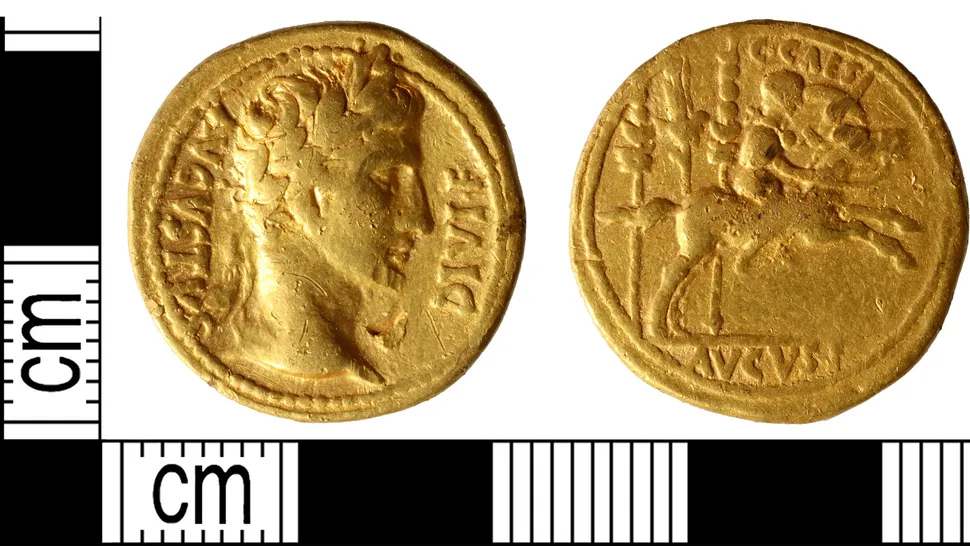
Posted on 07/13/2022 8:17:45 AM PDT by Red Badger
Experts believe that the "exceptional" treasure trove could lead to more discoveries in the area.
The front and back of a gold coin from the ancient Roman empire. The front shows Augustus Caesar and the back shows his grandson on a horse.

One of the gold coins from the Roman empire found in the English countryside. Augustus Caesar is featured on the front, and his grandson Gaius on horseback is depicted on the back. (Image credit: Two of the 11 gold coins from the Roman empire found in the English countryside. Photo by Adrian Marsden) A cache of gold coins found buried on farmland in the United Kingdom has caught the attention of coin experts, who have linked the treasure trove to the Roman Empire.
So far, metal detectorists have discovered 11 coins on a remote stretch of cultivated field located in Norfolk, a rural county near England's eastern coast, and experts remain hopeful that more could be unearthed in the future.
Damon and Denise Pye, a pair of local metal detectorists, found the first of several gold coins in 2017, after local farmers finished plowing the soil at the end of the harvest season, which made the land prime for exploration. The haul has been dubbed "The Broads Hoard" by local numismatists (coin specialists and collectors), for its geographic location near The Broads, a network of rivers and lakes that run through the English countryside.
"The coins were found scattered around in the plow soil, which has been churned up year after year, causing the soil to be turned over constantly and led to them eventually coming to the surface," said Adrian Marsden, a numismatist at Norfolk County Council who specializes in ancient Roman coins.
(Excerpt) Read more at livescience.com ...
As for NPS or the government trying to confiscate personal relic collections, they have tried to in the past unsuccessfully but I feel in the future they will try again.
I certainly don't think it's laziness.. seeing that they were mostly minted by slaves I doubt they were allowed to be lazy. Being manually produced .. while at the same time being under great pressure to produce as quickly as possible (sometimes in travelling mints) leads to poor workmanship. Especially at times of war... which was pretty much all the time. I believe the weight and purity would have been the prime focus rather than strike. I would also wager that the slaves doing the "striking" would be of the less skilled variety, easily replaceable and thrown into the job if they had finished other tasks (untrained) - as opposed to those artisans carving the die or those skilled workers creating and preparing the flans. (Cited from: https://www.cointalk.com/threads/why-are-so-many-ancients-so-far-off-center.345056/)
I think it has to do with the way they were struck. At an ANA Seminar in CO they were striking coins the old by-hand way. In order to make a decent looking piece, the operation was very slow because they had to be sure the two dies and planchet lined up to begin with. If the hammer was not brought down perfectly that could also cause so slip to the design.
…there was no collar like in modern minting.
…remember that there is no such thing as the 'ancient' way of doing things. Some dies were hinged; some anvil dies were concave making it easier to seat a blank. Some coins were struck hot making tongs needed; some were cold. I suspect at some point someone invented other ways of aligning dies but such technology may never have become widespread. Finding a coin of Aurelian which was not hinged means nothing when studying the coins of Tetricus (let alone Archaic or medieval coins).
I think the answer lies in the difficulty of the process and the minting goals. I think they were worried about the number of coins per pound (As) of silver and number of coins produced per day. Coins that were off center, brokage, unevenly struck or from worn dies circulated for a long time. It would be hard, and dangerous, to hold a small, hot flan; the punch die and strike with a small pointed hammer.
the flan placer was so concerning about this fingers that he used a pair of tongs…the loss of dexterity in using tongs would very likely increase miss hits.

I'll bet getting the weight of the planchet in tolerance was more important than what it looked like. After all, the design indicated the lump of metal was "OK" (just like the first ancient coins - (?) Lydians.) if most of it were showing, that's all that was needed.
nice tunics.
Goodness are you ever au courant with pop culture!


Wisconsin is lousy with Arrowheads. I’ve found a few through the years. :)
“...but they keep it plugging along year after year for some reason.”
Case in point? ‘24.’ While I liked the show, why did they keep bringing back Tony what’s his name? The guy is the most wooden actor ever! And I’ve seen him in other stuff - he’s just as wooden!
And why leave Audrey in a coma, yet keep raising Tony from the dead? LOL!
Beau and I have argued this point endlessly. ;)
I really liked their selection of actor Presidents, though. Still missing President ‘Dennis Hasbert’ and the guy that was portrayed as Nixon-like, but ended up being such a sleazebag had a good run too. ;)
The Battle of San Jacinto and the legend of the Yellow Rose
LOL!
Yep! My in-laws had (now sold) a beautiful farm with lots of mature trees and an awesome pond. That’s where we always hunted for them.
I could easily see an Indian camp right there. It had everything!
Ho-Chunk was the tribe that once lived in that part of southwest Wisconsin. Beau names his hunting dogs after Indian Tribes. We currently own a Ho-Chunk, an Oneida and a Fox. :)
I live in another county now, but still the same part of the state. I find a lot of flint, but nothing of any great quality. The pieces I find look to be practice pieces, or something that unfortunately broke on it’s way to becoming an arrowhead.

It was ever thus.
Ask Mel Fischer.
https://en.wikipedia.org/wiki/Mel_Fisher
It would still be an atrocity against history to melt irreplaceable Roman gold coins for their melt value, no matter who profits or does not profit.
“...something that unfortunately broke on it’s way to becoming an arrowhead.”
Judging by the number of unsuccessful arrowheads you find, the various Indian languages must have had a lot of words meaning “oh, crap”.
Wisconsin Indians must have been lousy archers............
I found a rather large flint 'chip' the other day and took it to Beau to ask him if he thought it might have been on it's way to being an Arrowhead. He said, 'Sure. Let's say that.'
He's such a help to me. *Rolleyes*
Wish:
Reality:

“Ask Mel Fischer.”
The site of the wreckage of the Atocha, called “The Bank of Spain” (a sandy area 22 feet deep and within 200 yards of the anchor location),[6] is still being worked on and treasures are slowly being recovered. The emeralds from the Atocha are some of the finest emeralds in the world. They come from the Muzo Mine in Colombia. The emeralds of Muzo are renowned for their color, fire, geometry, and as the world’s finest emeralds.[7][8]
The State of Florida claimed title to the wreck and forced Fisher’s company, Treasure Salvors, Inc., into a contract giving 25% of the found treasure to the state. Fisher’s company fought the state, claiming the find should be the company’s exclusively. After eight years of litigation, the U.S. Supreme Court ruled in favour of Treasure Salvors and it was awarded rights to all found treasure from the vessel on 1 July 1982.[9][10]The site of the wreckage of the Atocha, called “The Bank of Spain” (a sandy area 22 feet deep and within 200 yards of the anchor location),[6] is still being worked on and treasures are slowly being recovered. The emeralds from the Atocha are some of the finest emeralds in the world. They come from the Muzo Mine in Colombia. The emeralds of Muzo are renowned for their color, fire, geometry, and as the world’s finest emeralds.[7][8]
The State of Florida claimed title to the wreck and forced Fisher’s company, Treasure Salvors, Inc., into a contract giving 25% of the found treasure to the state. Fisher’s company fought the state, claiming the find should be the company’s exclusively. After eight years of litigation, the U.S. Supreme Court ruled in favour of Treasure Salvors and it was awarded rights to all found treasure from the vessel on 1 July 1982.[9][10]
You know who made out on THAT deal, right? After eight years of litigation? The lawyers, of course!
Thanks Red Badger.
So far, metal detectorists have discovered 11 coins on a remote stretch of cultivated field located in Norfolk... a pair of local metal detectorists, found the first of several gold coins in 2017... The haul has been dubbed "The Broads Hoard" by local numismatists...
"...did you hoard all the money yourself?" "No, my sister hoard half of if."
The other GGG topics added since the previous digest ping, chrono sort:
The law governing finds like this in the UK are clear.
To simplify the process, a committee of experts determines a market value, some museum buys it, and the money is split 50/50 between the finder and the land owner. The only thing the government gets is taxes. Of course, taxes in the UK tend to be high.
finding a few coins scattered in a plowed field, isn’t a hoard to me. To me, a hoard is finding dozens of coins in a single spot, where they were probably buried.
Disclaimer: Opinions posted on Free Republic are those of the individual posters and do not necessarily represent the opinion of Free Republic or its management. All materials posted herein are protected by copyright law and the exemption for fair use of copyrighted works.